|
Edited
by Frank R. Shaw, FSA Scot, Dawsonville, GA, USA
Email:
jurascot@earthlink.net
As
I write this, Susan and I are in Paris, the last leg of a three-part journey
which took us to London, Glasgow, Edinburgh, St. Andrews, Alloway and now
the great city by the Seine. I spoke on the subject of Robert Burns
Lives! at the annual conference last Saturday hosted by the University
of Glasgow’s Centre for Robert Burns Studies. I thoroughly enjoyed the
symposium, an afternoon affair lasting five hours. Dr. Gerry Carruthers,
Director of the Centre, along with able Associate Director Dr. Kirsteen
McCue and their staff are to be congratulated for sponsoring such a
well-rounded and significant meeting. I met lots of good Burns people who
are not members of the “Burns Police” and made us very welcome. Several
offered to contribute to the website and I plan to hold them to their
promises. I managed to upset only one member of the “police” so my record of
rattling the cage is in tact. To quote a good friend, it is “pretty odd that
in Glasgow someone should be precocious about pronunciation”.

Nigel Leask was the keynote speaker. Nigel is a humble, gregarious man, and
Regius Professor of English Literature at the university. He is regarded as
one of the foremost Romantic scholars of his generation. Professor Leask is
the latest winner of the Saltire Research Book Award with his publication
entitled Burns and Pastoral that I plan to review as soon as I obtain
a copy. Dr Natalia Kaloh Vid’s speech on the “Ideological Adaption of Robert
Burns’s Poetry in the Former Soviet Union” was the highlight of the
conference for me. She is from Slovenia and did a masterful job contrasting
the work of Sumuil Marshak and Burns. Marshak was responsible for a large
Burns movement in Russia over a seventy-year period. Pauline Mackay’s talk
was entitled “Robert Burns Beyond Text”, a topic she had shared at the Burns
Club of Atlanta on a recent visit to the States while serving as the W.
Ormiston Roy Fellow sponsored by the University of South Carolina and Dr. G.
Ross Roy. Congratulations to Pauline who has just been awarded her PhD at
the University of Glasgow. Susan and I are proud for her and value our
relationship with her!
Having heard Dr. Valentina Bold speak at the Library of Congress in
Washington two years ago, it was not surprising she didn’t miss a beat with
her fine paper on “Jean Burns to Mrs. Riddell: The Discovery and
Repatriation of a Letter from 1804”. Her presentation added significantly to
the conference. She was followed by Sir Kenneth Calman, internationally
renowned physician and Chancellor of the University of Glasgow and current
Chairman of the National Trust of Scotland. Sir Calman gave a very
interesting and illuminating talk on “Remember Tam o’ Shanter’s Mare; A
Study of Burns and Health”.
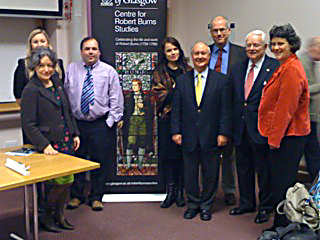
L-R: Valentina Bold, Pauline Mackay, Gerry
Carruthers, Natalia Kaloh Vid,
Kenneth Calman, Nigel Leask, Frank Shaw and Kirsteen McCue
It
is always good to visit with old friends such as Bill Dawson. Also, Dr.
David Purdie stopped by the podium to speak and it brought to mind a bit of
Sir Walter Scott we had emailed each other about several years ago. Both
Dawson and Purdie have contributed to the pages of Robert Burns Lives!.
David promised a new paper for our readers sometime in the near future that
will be quite newsworthy! (His paper was actually posted on Robert
Burns Lives! on February 3, 2011.)
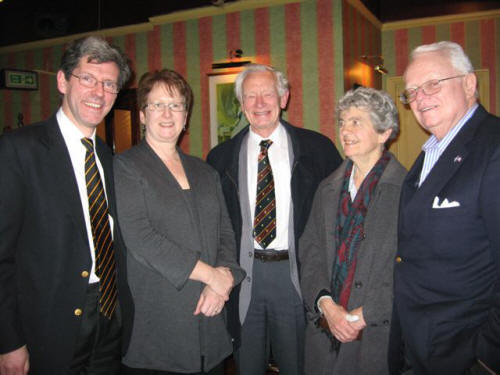
(L-R): Clark and Ann McGinn, Jim and Wendy
Henderson, Frank Shaw -
after enjoying the fine English pies at Porter's in London.
It
was good to see Clark McGinn, Jim Henderson and their wives, Ann and Wendy,
in London at Porter’s English Restaurant to once again sit around a table,
break bread, and share old memories. Some of the stories we heard have been
told before, and I’m sure we will hear them again! A bit of Auld Lang
Syne, you might say! For me, Kate Taylor sings it best in her version of
the song that is reputedly sung or played more often in Hollywood movies
than any other song except one – Happy Birthday – and one line of
Kate’s version reaches out to me when I think of these London friends…
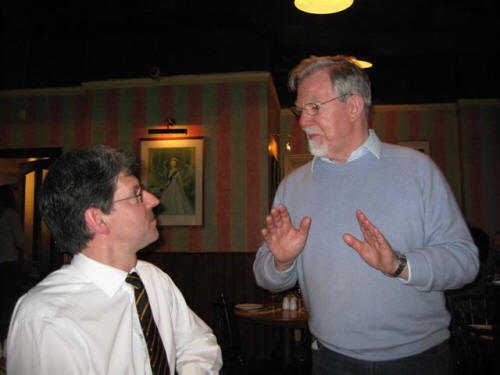
Clark McGinn with Porter's owner, Richard
Bridgeman, 7th Earl of Bradford.
But
seas between us have roared and swelled
Since Auld Lang Syne.
Interestingly Porter’s owner, Richard Bridgeman, 7th
Earl of Bradford, stopped by our table, commented on our seemingly “very
jolly gathering” and told us several humorous stories as well.
Yes, we also had some personal time and were able to see a matinee
performance of Love Never Dies, sequel to The Phantom of
the Opera. The next afternoon we enjoyed tea at the newly renovated
Savoy. (Yes, Rachel, I really did!) Perhaps the flat we rented just behind
Harrods added to the festivities of our too few days in London. We would
have lunch around town or in the neighborhood and bring items in from
Harrods, Sainsbury’s or Mark and Spencer for an evening snack in the lovely
apartment along with a good bottle of wine. The weather was cold in London
and even colder in Glasgow and Paris but neither of us cared since we were
on holiday. We just wrapped up and walked and walked ‘til we found ourselves
unbuttoning coats to cool off a bit or to make a stop at a Starbuck’s.
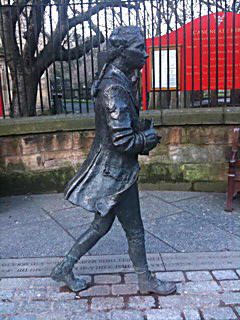
Statue of Robert Fergusson in front of Canongate
Kirk in Edinburgh
Susan and I enjoyed immensely seeing our old friend Giuliano in Edinburgh.
He owns the ever popular Italian restaurant, Giuliano’s, (what better name
than his own) at the beginning of Leith Walk across from the Edinburgh
Playhouse. The highlight of this particular day was visiting the auld
Canongate Kirk to pay our respects at the grave of Robert Fergusson and see
the statue of him in front of the kirk depicting his walking toward Holyrood.
It is hard to believe that this young poet, who meant so much to Robert
Burns, died at 24 years of age and would have such an influence on Burns.
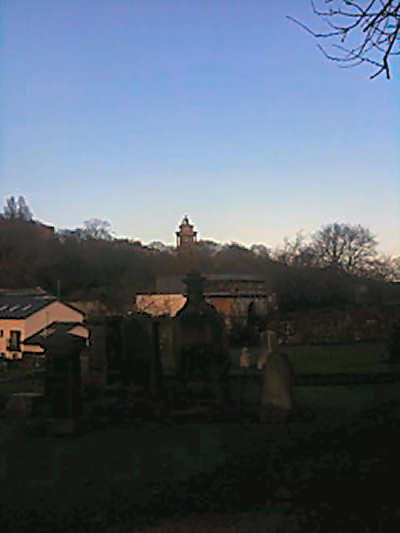
Edinburgh's Burns Memorial in the distance
Robert Burns petitioned the powers that be to allow him to erect a headstone
on the grave of Fergusson. When permission was granted, he hired an
architect Robert Burn (no kin) to assemble it. Listen to poet Burns describe
his relationship with Burn the architect in a letter to Peter Hill:
He was two years erecting it, after I
commissioned him for it; and I have been two years paying him, after he
sent me his account. So he and I are quits. He had the hardiesse (French
for boldness) to ask me interest on the sum; but considering that the
money was due by one Poet, for putting a tomb-stone over another, he
may, with grateful surprise, thank Heaven that ever he saw a farthing of
it.” (James Mackay, A Biography of Robert Burns, Page 280)
Do
yourself a favor when you visit Edinburgh. As you stand at the foot of
Fergusson’s grave, turn around and look toward eleven o’clock and there in
the distance, a few hundred yards, is the city’s Memorial to Robert Burns.
You do not want to miss that view while vacationing in this great city.
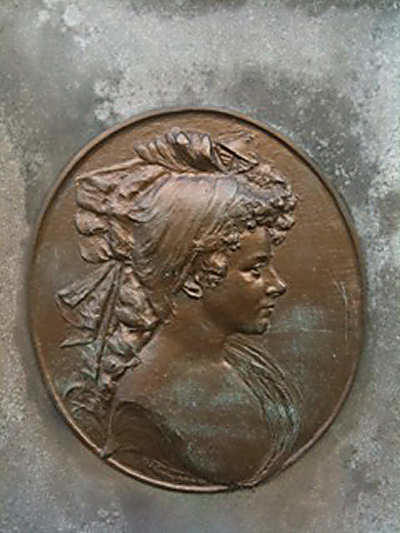
Clarinda as depicted on stone wall above her
grave
Susan found a grave on the other side of the kirk of another person who
played prominently in the life of Burns - Clarinda. There she is, portrayed
on the wall, lovely as ever. No wonder Burns was enchanted by her. The sign
out front boasts of the significant names of people buried in the kirk yard
and it lists her as “CLARINDA Mrs. MACLEHOSE, Sweetheart of Poet Robert
Burns”. Describing her as Burns’s sweetheart may or may not be so in the
true sense of the word. I think they enjoyed each other’s company and they
certainly enjoyed teasing one another, maybe more, but I do not know about
the word “sweetheart”. Yet, over 80 letters tell us a lot about their
relationship. It does seem that Burns had finally met a female who was his
match in conversation.
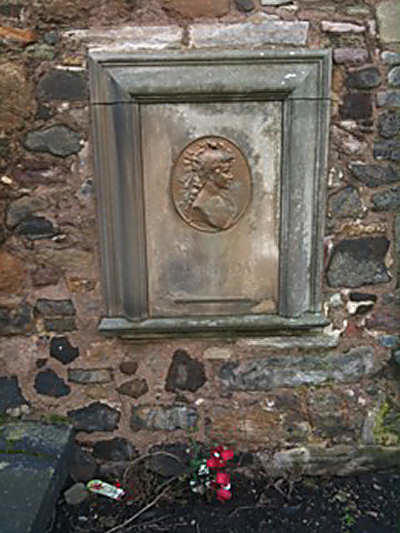
Roses for Clarinda
But I’ll tell you what I did besides taking pictures of her gravesite. The
wind was so strong that day until benches and signs were sprawled all over
the streets of Edinburgh. Close to her grave in the pathway was a bound
bundle of artificial red roses blown in like the tumbleweed we see in
western movies. Even though the roses were in “no man’s land”, I picked them
up and placed them on her grave. Why not? What comes to my mind when I think
of Burns and Clarinda are these lines by Burns that good friend Dr. Jim
Flannery, Emory University’s Yeats professor in Atlanta, refers to as
“frustrated desire”!
Ae
fond kiss, and then we sever;
Ae farewell, alas, forever!
Had
we never lov’d sae kindly,
Had we never lov’d sae blindly,
Never met - or never parted,
We had ne’er been broken-hearted.
The next day was Monday and we traveled by train to the University of St.
Andrews for lunch with Robert Crawford and a tour around the ever impressive
campus. Crawford is an internationally acclaimed poet and author of many
books. Two of my favorites are The Bard, Robert Burns, a
Biography and The Best Laid Schemes, Selected Poetry & Prose of
Robert Burns co-edited with Christopher MacLachlan. Dr. Crawford had
arranged for us to meet Dr. Norman Reid, Head of Special Collections and
Keeper of Manuscripts. He had prepared a display of some of the oldest
“treasures” of St. Andrews for us to see and enjoy. Dr. Reid is also a
medieval historian and an authority on the Scottish Wars of Independence.
Susan and I will forever be grateful for the courtesies of both gentlemen
who made it a “Red Letter Day” as one of my graduate professors, Dr. Leo
Green, used the phrase to describe a significant day in the life of the
participants.
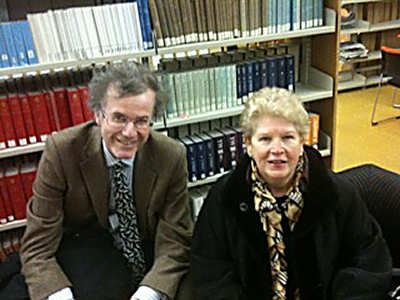
Dr. Robert Crawford and Susan Shaw in the St.
Andrews Library
On
the next day, Tuesday, we found our way down to Ayr by rail to join up with
old friend Kenneth Simpson. Ken, one of the nicest men you will ever meet,
had arranged a private tour with David Hopes, Curator of the new Robert
Burns Museum. To visit this building is an experience everyone needs to be a
part of. Burns has long been given his due as the National Bard of Scotland,
but there has never been a place to display all the manuscripts and
artifacts owned by the museum. Many had even been loaned to other
institutions for years to protect them from damage at the old museum.
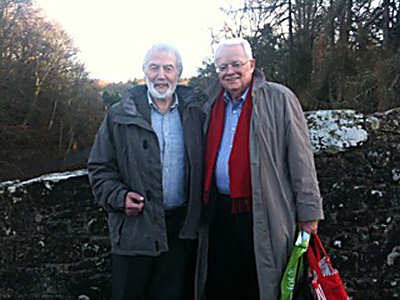
Ken Simpson and Frank Shaw in Alloway
A
lot of money was spent on the new building and, in this writer’s opinion, it
is worth every pound of the nearly 21 million it cost, including the turf
roof. How does such a small country, having its own share of financial
problems, if not more, like the rest of the world, manage to invest such a
large sum to commemorate Robert Burns? Below is a breakdown of where the
money came from:
£5.3 million, Heritage Lottery Fund
£8 million, Scottish Government
£3 million, S. Ayrshire Council (land gift)
£5 million, grants and donations from charitable sources
Thank you, David Hopes, for the behind-the-scenes look where the 321
original Burns manuscripts and other related items are stored in their safe
and controlled environment in the bowels of this magnificent building,
perhaps the most singular tribute to Robert Burns in the world. This
marvelous building makes me want to stay over a couple of nights on my next
visit to Ayr for some study and research.

Alloway Kirk
The three of us made our way to the old kirk yard where Tam o’ Shanter
played such a big role. I wanted to see the bell that had been restored to
its rightful place and to silently thank William Burnes and Agnes Brown
Burnes for their gift to the world in the person of their son Robert Burns.
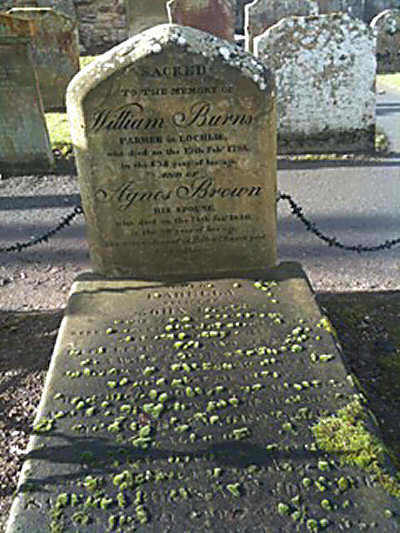
At grave of Burns' parents, William and Agnes
Burnes
Ken, Susan, and I then walked from the museum to the Brig o’ Doon House
Hotel just down the street for lunch that Ken had arranged. I do not
remember what they ordered for lunch, but my eyes lit up when I saw haggis
listed on the menu! This warm and lovely place was established in 1827 so I
reasoned the haggis had to be good. Leave it to Burns to describe this
iconic Scottish dish as no one else possibly could as the ‘great chieftain
o’ the pudding-race’.
I’ve had a lot of good haggis but none better that what I had for lunch that
day at the Brig o’ Doon and the owners can be proud of their recipe because
it was as Burns said it should be…
“O
what a glorious sight, Warm-reekin, rich!”
We
hurriedly made our way to catch the train back to Glasgow. Ken rode with us
as far as Kilwinning where he changed trains to reach his home. Thanks, Ken,
for a wonderful day that will never be forgotten.
Then we were up early on Wednesday to catch a plane from Edinburgh to Paris
via London’s Heathrow. Another of my favorite writers, Ernest Hemingway, in
1950 once described Paris to a friend this way:
“If you are lucky enough to have lived in Paris
as a young man,
then wherever you go for the rest of your life, it stays with you,
for Paris is a moveable feast.”
We
always visit the haunts of Hemingway like the Brasserie Lipp, Café des Deux
Magots, and Harry’s New York Bar that he enjoyed in the early 1920s while
living there with wife Hadley. Some of the bars and restaurants today still
have pictures of him on their walls.
The day before leaving on our trip to Glasgow, I had a call from Ross Roy.
We talked about our trip and he mentioned several things he thought Susan
and I might like to check out in London, Scotland and Paris. I especially
remember what he said about Paris. After all, he should know a little about
that magical city since he has an earned PhD from the University of Paris
and his lovely wife Lucie is a most remarkable French lady. “Frank”, he
said, “Paris will be fun because Paris is always fun!” It is a city of
enchantment. We already look forward to our next visit.
Tomorrow we return to Atlanta after 15 days of travel and then up to
Waverley, our home now on Lake Lanier in the north Georgia mountains. We
have enjoyed our trip but it is time to go home to reacquaint ourselves with
our easy chairs, a roaring fire and some home-cooked meals, still the best
meals to be had anywhere. Our thanks to one and all, particularly Gerry
Carruthers and Kirsteen McCue for an outstanding conference and for making
this trip a wonderful experience!
EDITOR’S NOTE: Even though a major part of this article was written
while in Paris, it was concluded at home and not posted on Robert Burns
Lives! earlier due to the outpouring of articles by other writers that have
been posted on our web site as mentioned in the first paragraph above. My
thanks to one and all! (FRS: 4.19.11) |

